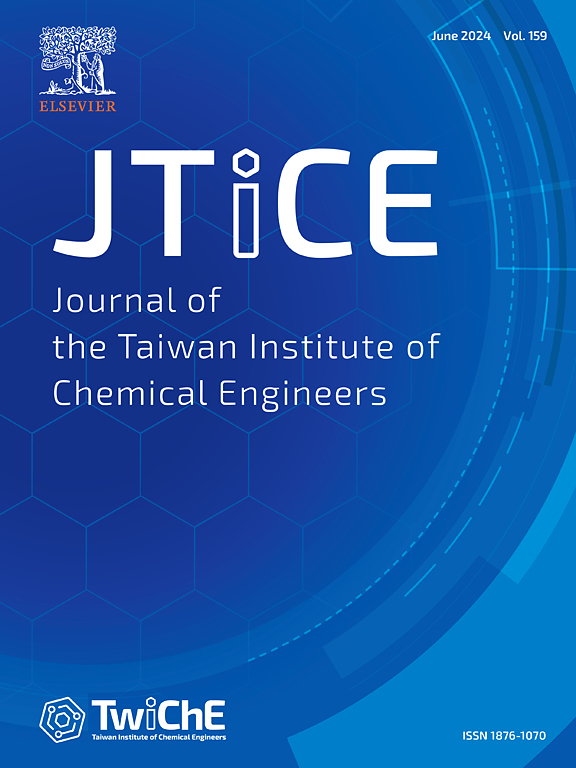三元双z型Ni3(VO4)2/Cu2O/CoMoS2纳米异质结可见光诱导光催化降解左氧氟沙星的设计:动力学、降解途径和毒性评价
IF 6.3
3区 工程技术
Q1 ENGINEERING, CHEMICAL
Journal of the Taiwan Institute of Chemical Engineers
Pub Date : 2025-03-01
DOI:10.1016/j.jtice.2025.106017
引用次数: 0
摘要
由于抗生素对生态系统和人类健康的潜在影响,抗生素在环境中的广泛存在是一个值得关注的问题。与许多其他环境污染物不同,抗生素的设计是为了在人体内保持稳定和有效。然而,这种有利的特性可以导致它们在环境设置中长期存在并抵抗破坏。方法利用CoMoS2、Cu2O和Ni3(VO4)2等纳米材料,设计了Ni3(VO4)2/Cu2O/CoMoS2双Z-scheme纳米异质结,以提高左氧氟沙星(LVF)的光催化降解效率。采用化学共沉淀法和溶剂热法合成了该材料。重要发现:扫描电子显微镜和元素映射揭示了纳米团簇的形态、无定形性质和异质结的成功形成。x射线衍射研究证实了合成材料的纯度,而x射线光电子能谱则验证了它们的化学状态和成键性质。布鲁诺尔-埃米特-泰勒分析表明,纳米碳纳米管的表面积和介孔性质增加。紫外-可见DRS显示了NCs对可见光的成功敏化,显示出2.30 eV的带隙。此外,PL研究表明NCs中的载流子重组减少,ESR证实光催化过程中活性氧(ROS)的产生增加,包括O2。-和。oh。该光催化剂对LVF的光催化去除率达到99.07%。有趣的是,这些NCs在几个周期内表现出良好的稳定性,在离子存在下表现出较长的活性。此外,气相色谱-质谱分析研究揭示了LVF可能的降解途径和无害终产物的形成。本文章由计算机程序翻译,如有差异,请以英文原文为准。

Designing of ternary double Z-scheme Ni3(VO4)2/Cu2O/CoMoS2 nano-heterojunction for visible light-induced photocatalytic degradation of levofloxacin: Kinetics, degradation pathway and toxicity assessment
Background
The extended presence of antibiotics in the environment is a significant concern due to its potential impact on ecological systems and human health. Unlike many other environmental pollutants, antibiotics are intentionally designed for stability and effectiveness within the human body. However, this advantageous characteristic can lead to their prolonged existence and resistance to breakdown in environmental settings.
Methods
In this investigation, we utilize nanomaterials such as CoMoS2, Cu2O, and Ni3(VO4)2 to intricately engineer a double Z-scheme nano-heterojunction Ni3(VO4)2/Cu2O/CoMoS2, aiming to enhance the photocatalytic degradation efficiency of levofloxacin (LVF). The materials were synthesized by chemical co-precipitation and solvothermal method.
Significant findings
Scanning electron microscopy and elemental mapping reveals the nanocluster morphology, amorphous nature, and successful formation of heterojunctions. X-ray diffraction studies confirm the purity of the synthesized materials, while X-ray photoelectron spectroscopy validates their chemical states and bonding nature. Brunauer–Emmett–Teller analyses demonstrate an increased surface area and mesoporous nature of the NCs. UV–visible DRS illustrates the successful sensitization of NCs to visible light, exhibiting a bandgap of 2.30 eV. Furthermore, PL studies indicate reduced charge carrier recombination in the NCs, and ESR validates enhanced reactive oxygen species (ROS) production during photocatalysis, including O2.- and .OH. The photocatalyst achieved a remarkable 99.07 % photocatalytic elimination of LVF. Interestingly, these NCs show good stability over several cycles and prolonged activity in the presence of ions. Furthermore, gas chromatography-mass spectrometry study reveals possible LVF degradation pathway and formation of non-hazardous end products.
求助全文
通过发布文献求助,成功后即可免费获取论文全文。
去求助
来源期刊
CiteScore
9.10
自引率
14.00%
发文量
362
审稿时长
35 days
期刊介绍:
Journal of the Taiwan Institute of Chemical Engineers (formerly known as Journal of the Chinese Institute of Chemical Engineers) publishes original works, from fundamental principles to practical applications, in the broad field of chemical engineering with special focus on three aspects: Chemical and Biomolecular Science and Technology, Energy and Environmental Science and Technology, and Materials Science and Technology. Authors should choose for their manuscript an appropriate aspect section and a few related classifications when submitting to the journal online.

 求助内容:
求助内容: 应助结果提醒方式:
应助结果提醒方式:


